Transform your home office into an energy-efficient oasis by blending smart design with comfort. Maximize natural light and use LED bulbs for artificial lighting. Install a smart thermostat to automate temperature control and reduce energy waste. Choose Energy Star certified devices and smart power strips to minimize phantom energy consumption. Implement natural ventilation techniques and improve insulation for better climate control. Opt for ergonomic, eco-friendly furniture and add air-purifying plants to boost your workspace's health factor. Don't forget cable management to eliminate unnecessary power draw. These strategies will help you create a sustainable, comfortable home office that boosts productivity while lowering your energy bills.
Optimal Lighting Strategies
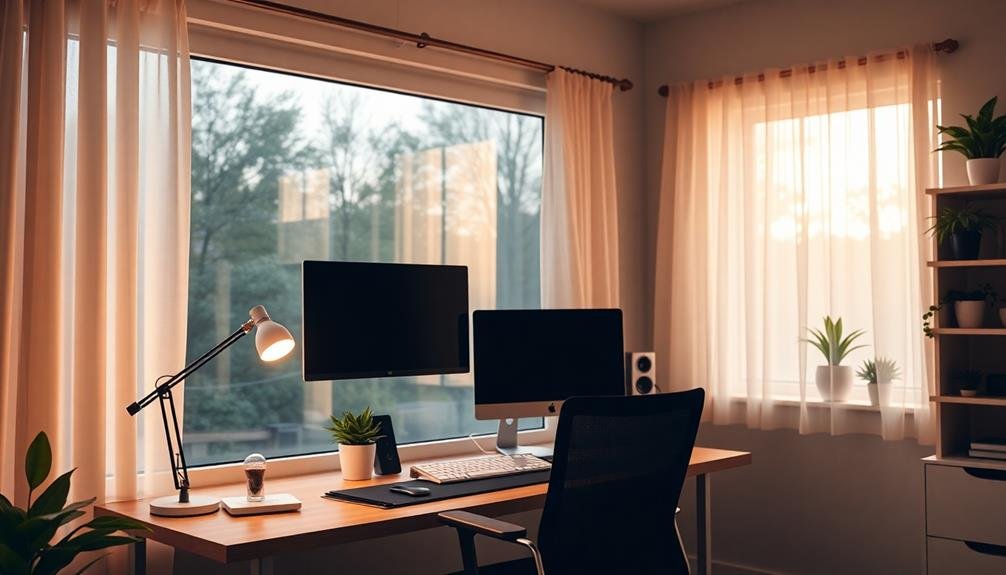
Nearly every home office can benefit from optimized lighting strategies.
You'll want to maximize natural light while incorporating energy-efficient artificial lighting to create a comfortable and productive workspace. Start by positioning your desk near a window to take advantage of daylight, but use blinds or curtains to control glare and heat gain.
For artificial lighting, opt for LED bulbs, which use up to 75% less energy than traditional incandescent bulbs.
Layer your lighting with a combination of ambient, task, and accent lights. Install overhead fixtures with dimmer switches for ambient lighting, and use adjustable desk lamps for focused task lighting. Consider adding under-cabinet lights or wall sconces for accent lighting to reduce eye strain and create a balanced atmosphere.
Don't forget about smart lighting solutions.
Install motion sensors in less frequently used areas, and use smart bulbs that can be controlled via smartphone apps or voice commands. These allow you to easily adjust brightness and color temperature throughout the day, mimicking natural light patterns and potentially boosting your productivity.
Smart Thermostat Integration
Integrating a smart thermostat into your home office can greatly boost energy efficiency.
You'll benefit from automatic temperature adjustments based on your work schedule, remote control capabilities for on-the-go management, and detailed energy usage insights.
These features not only help you maintain a comfortable workspace but also allow you to optimize your heating and cooling costs over time.
Automatic Temperature Adjustments
Smart thermostats frequently serve as the cornerstone of an energy-efficient home office. These devices excel at automatic temperature adjustments, learning your habits and preferences over time. You'll find that your thermostat begins to anticipate your needs, adjusting the temperature before you even realize you're uncomfortable.
By analyzing your daily routines, smart thermostats can create a custom schedule that maximizes both comfort and energy savings. They'll lower the temperature when you're away or asleep, and warm up your office just before you start work. Many models also offer geofencing capabilities, detecting when you're approaching home and adjusting accordingly.
These intelligent systems provide additional benefits:
- Integration with other smart home devices for thorough energy management
- Remote access via smartphone apps for on-the-go adjustments
- Detailed energy reports to help you identify areas for improvement
You'll appreciate the seamless comfort these automatic adjustments provide while simultaneously reducing your energy consumption. As your smart thermostat learns and adapts, you'll notice a decrease in your utility bills without sacrificing comfort.
This technology guarantees your home office remains at the perfect temperature, allowing you to focus on your work rather than constantly fidgeting with thermostat settings.
Remote Control Capabilities
Remote control features of smart thermostats bring unparalleled convenience to your energy-smart home office. You can adjust your office temperature from anywhere using your smartphone or tablet. This means you'll never waste energy heating or cooling an empty space. If you're running late or decide to work from a coffee shop, simply open the app and adjust your thermostat accordingly.
Many smart thermostats integrate with voice assistants like Alexa or Google Home. You can change settings hands-free while deep in work, simply by saying, "Hey Google, set the office temperature to 72 degrees."
Some advanced models even allow you to create different temperature zones in your home, ensuring your office stays comfortable without affecting other areas.
Remote access also enables you to monitor your energy usage in real-time. You'll receive alerts about unusual patterns or when it's time to change your air filter. This data helps you make informed decisions about your energy consumption, potentially leading to significant cost savings.
Additionally, you can easily program your thermostat to align with your work schedule, optimizing comfort and efficiency throughout your workday.
Energy Usage Insights
A wealth of energy usage insights becomes available when you integrate a smart thermostat into your home office setup.
These intelligent devices not only regulate temperature but also collect and analyze data on your energy consumption patterns. You'll gain a thorough understanding of how your heating and cooling habits impact your energy bills and carbon footprint.
Smart thermostats provide detailed reports on your daily, weekly, and monthly energy usage. You can easily identify peak consumption times and adjust your work schedule accordingly.
They'll also suggest ideal temperature settings based on your preferences and local weather conditions, helping you strike a balance between comfort and efficiency.
Many smart thermostats offer the following features to enhance your energy awareness:
- Real-time energy consumption tracking
- Customized energy-saving tips
- Integration with utility company programs for additional savings
Energy-Efficient Equipment Selection
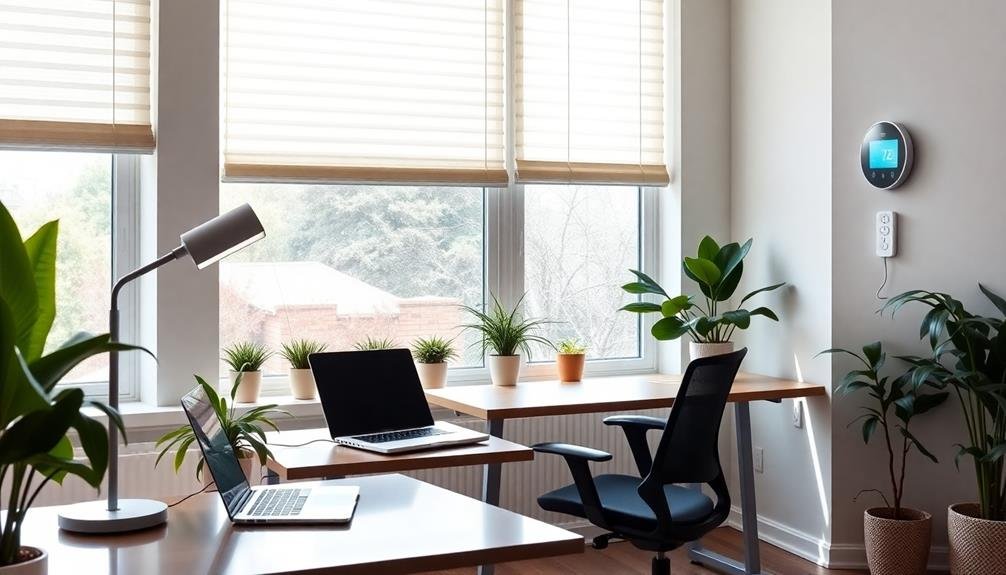
When setting up your energy-smart home office, selecting the right equipment is essential.
Start by choosing Energy Star certified devices, which consume less power and can greatly reduce your energy bills.
Don't forget to incorporate smart power strips, which automatically cut power to idle devices and eliminate phantom energy consumption.
Energy Star Certified Devices
Choosing from among Energy Star certified devices is a crucial step in creating an energy-efficient home office. These devices have been rigorously tested and certified to meet strict energy efficiency guidelines set by the U.S. Environmental Protection Agency and the Department of Energy.
By opting for Energy Star certified equipment, you'll not only reduce your energy consumption but also save money on utility bills.
When shopping for office equipment, look for the distinctive Energy Star label on:
- Computers and monitors
- Printers and multifunction devices
- Desk lamps and light fixtures
Energy Star certified computers use 30-65% less energy than standard models, while certified monitors consume 20-30% less.
You'll find that these devices often come with advanced power management features, such as automatic sleep modes and efficient power supplies.
Printers and multifunction devices with the Energy Star label use 40% less energy than conventional models, thanks to features like automatic double-sided printing and low-power sleep modes.
Smart Power Strips
Smart power strips serve as an essential tool in your energy-efficient home office arsenal. These devices help you combat phantom energy loss by automatically cutting power to devices in standby mode. You'll save money and reduce your carbon footprint without sacrificing convenience.
When selecting a smart power strip, consider its features and compatibility with your office setup. Look for models with multiple outlets, some of which remain always-on for devices that need constant power. USB charging ports are a bonus, eliminating the need for separate chargers.
Here's a comparison of smart power strip features:
| Feature | Basic | Advanced | Premium |
|---|---|---|---|
| Auto-off | Yes | Yes | Yes |
| Always-on outlets | 1-2 | 2-3 | 3-4 |
| USB ports | No | 2-4 | 4-6 |
| Wi-Fi connectivity | No | Some | Yes |
To maximize energy savings, plug your computer into the control outlet and connect peripherals to the switchable outlets. This way, when you power down your computer, the strip automatically cuts power to monitors, speakers, and other accessories. You'll enjoy a more energy-efficient workspace without the hassle of manually unplugging devices or flipping switches.
Natural Ventilation Techniques
A gentle breeze wafting through your home office can make a world of difference in comfort and energy efficiency.
Natural ventilation techniques harness outdoor air movement to cool and freshen your workspace without relying on energy-intensive air conditioning systems. You'll reduce your carbon footprint and potentially lower your energy bills by incorporating these strategies.
Start by evaluating your office's layout and identifying potential airflow paths. Position your desk near windows to take advantage of cross-ventilation. Open windows on opposite sides of the room to create a natural draft. If you're in a single-window space, use a fan to enhance air circulation.
Consider installing window treatments that allow for airflow control. Adjustable blinds or louvered shutters let you fine-tune the amount of air and light entering your office.
Don't forget about vertical spaces – skylights or clerestory windows can create a chimney effect, drawing hot air upward and out of your workspace.
For maximum effectiveness, try these natural ventilation boosters:
- Install window screens to keep insects out while allowing air in
- Use plants to naturally purify and humidify the air
- Place a small water feature nearby to create a cooling effect through evaporation
Insulation and Weatherproofing Tips
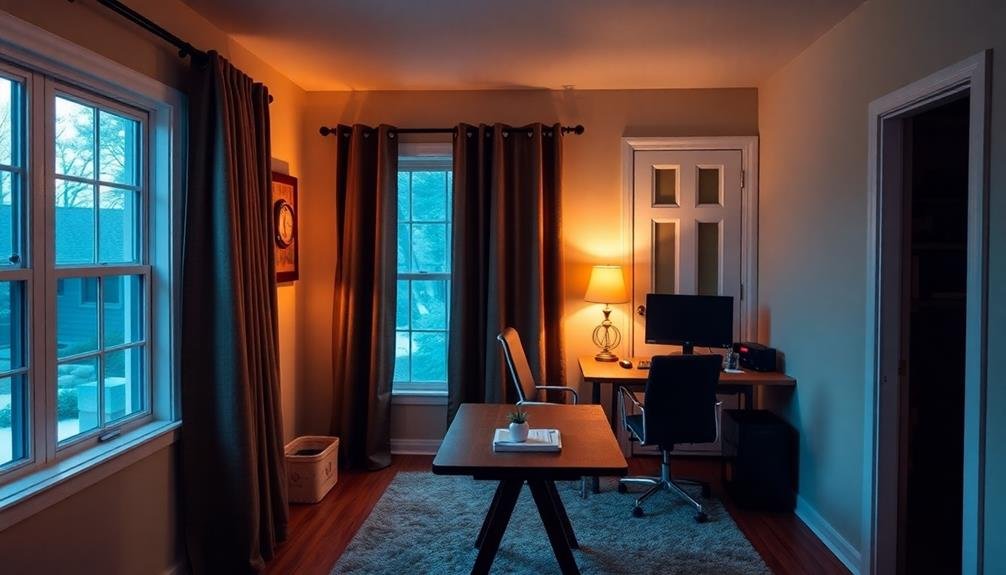
To make your home office truly energy-efficient, you'll need to focus on insulation and weatherproofing.
Start by sealing windows and doors to prevent drafts, then add attic insulation to keep heat from escaping through your roof.
Don't forget to install weatherstripping effectively around all openings to create a tight seal against the elements.
Seal Windows and Doors
Sealing windows and doors effectively is essential for maintaining an energy-efficient home office. Start by inspecting all windows and doors for gaps, cracks, or worn weatherstripping. Replace old weatherstripping with new, high-quality materials to guarantee a tight seal. For windows, consider using rope caulk or removable caulk strips to seal gaps during colder months.
Don't forget to address the space beneath your doors. Install door sweeps or draft stoppers to prevent air from seeping in or out. For sliding glass doors, check the track for debris and clean it thoroughly. Then, apply weatherstripping along the sides and bottom to minimize drafts.
When sealing windows, pay special attention to these areas:
- Around the frame where it meets the wall
- Between the sash and frame
- Where the upper and lower sashes meet in double-hung windows
For a more permanent solution, consider applying clear caulk around window frames both inside and outside. This won't only improve energy efficiency but also prevent moisture from entering your home office.
Add Attic Insulation
While sealing windows and doors is important, don't overlook the significant impact of attic insulation on your home office's energy efficiency.
Proper attic insulation acts as a barrier, preventing heat transfer between your living space and the outside environment. This means your home office stays cooler in summer and warmer in winter, reducing the strain on your HVAC system.
To add attic insulation, first assess your current insulation levels. If you can see your floor joists, you need more insulation.
Choose between fiberglass batts, blown-in cellulose, or spray foam insulation based on your budget and needs. Aim for an R-value of R-38 to R-60, depending on your climate zone.
Before installing, seal any air leaks in the attic floor and guarantee proper ventilation.
When laying insulation, cover the entire attic floor evenly, but don't compress it, as this reduces its effectiveness. Be careful not to block soffit vents or cover recessed lighting fixtures.
If you're not comfortable DIYing this project, hire a professional insulation contractor. They'll guarantee proper installation and can recommend the best insulation type for your specific home office setup.
Install Weatherstripping Effectively
In addition to attic insulation, weatherstripping plays an essential role in maintaining your home office's energy efficiency. By sealing gaps around windows and doors, you'll prevent air leaks that can compromise your heating and cooling efforts.
To install weatherstripping effectively, first identify problem areas by conducting a simple draft test using a candle or incense stick.
Choose the right type of weatherstripping for each location:
- Adhesive-backed foam tape for windows and lightweight doors
- V-strip weatherstripping for sliding windows and doors
- Door sweeps for the bottom of exterior doors
Clean the surfaces thoroughly before application to guarantee proper adhesion. Measure carefully and cut the weatherstripping to fit precisely.
For doors, install the strips on the sides and top of the door frame, making sure they compress slightly when the door closes. For windows, apply weatherstripping to the sash or frame where it makes contact when closed.
Don't forget to weatherstrip attic hatches and basement doors, as these are often overlooked sources of drafts.
Regularly inspect and replace weatherstripping as needed, typically every few years, to maintain its effectiveness. By properly installing and maintaining weatherstripping, you'll create a more comfortable and energy-efficient home office environment.
Solar-Powered Office Solutions
Harnessing the power of the sun can transform your home office into an energy-efficient workspace. Solar panels installed on your roof or property can generate clean electricity to power your office equipment and lighting.
You'll reduce your carbon footprint and potentially save money on energy bills over time.
Start by evaluating your energy needs and consulting with a solar professional to determine the right system size for your home office. Consider battery storage options to guarantee power availability during cloudy days or nighttime work sessions.
You can also invest in solar-powered gadgets like chargers for your devices or solar-powered desk lamps to supplement your main solar system.
Don't forget about passive solar design principles. Position your desk near south-facing windows to maximize natural light and warmth.
Use light-colored walls and reflective surfaces to distribute sunlight throughout your workspace. Install solar shades or adjustable blinds to control glare and heat gain during peak sun hours.
Cable Management for Energy Savings
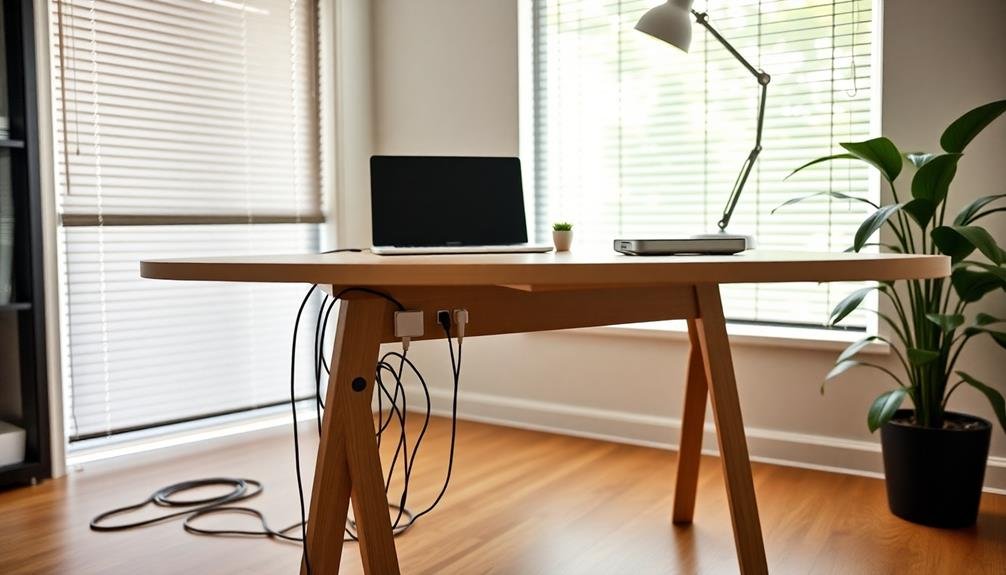
Effective cable management in your home office goes beyond just tidying up your workspace. It's an essential factor in reducing energy waste and improving overall efficiency. By organizing your cables, you'll eliminate unnecessary power draw from devices that aren't in use and make it easier to unplug equipment when it's not needed.
Start by evaluating your current setup and identifying areas where cables are tangled or disorganized. Invest in cable clips, ties, or sleeves to bundle cords together neatly. Use a power strip with an on/off switch to easily cut power to multiple devices at once, reducing standby power consumption.
Consider these energy-saving cable management strategies:
- Label your cables for quick identification and easier unplugging
- Use shorter cables to reduce resistance and minimize energy loss
- Opt for wireless peripherals to reduce cable clutter and energy use
Don't forget about your computer's power settings. Configure your device to enter sleep mode when inactive and adjust the display brightness to conserve energy.
Ergonomic and Eco-Friendly Furniture
Choosing ergonomic and eco-friendly furniture for your home office is a win-win decision. You'll improve your comfort and productivity while reducing your environmental impact.
Start with an adjustable chair that supports your spine and promotes good posture. Look for chairs made from recycled materials or sustainable wood to minimize your carbon footprint.
Your desk should be at the right height to prevent strain on your wrists and shoulders. Consider a standing desk or a sit-stand converter to alternate between sitting and standing throughout the day. This not only benefits your health but also reduces energy consumption by encouraging movement.
Opt for furniture made from sustainable materials like bamboo, reclaimed wood, or recycled plastic. These choices often require less energy to produce and can be recycled at the end of their life cycle.
Don't forget about lighting; use LED desk lamps with adjustable arms to reduce eye strain and save energy.
Lastly, incorporate plants into your office design. They naturally purify the air, reducing the need for energy-consuming air purifiers.
Plus, they add a touch of nature to your workspace, enhancing your overall well-being and productivity.
Power-Saving Window Treatments
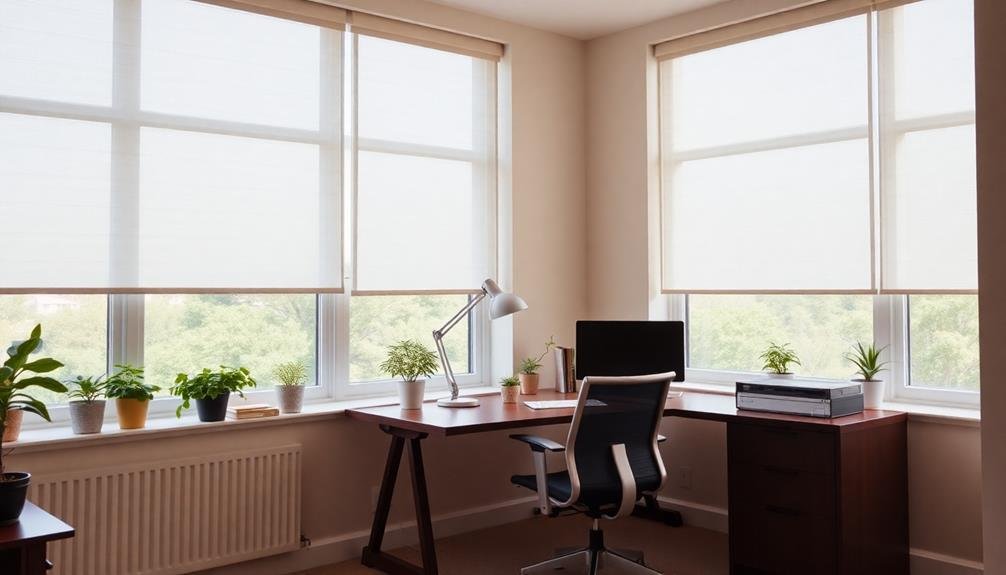
Your home office's windows play an essential role in energy efficiency. They can either be a source of heat gain in summer and heat loss in winter, or they can help regulate your office's temperature and lighting.
To maximize energy savings, consider installing power-saving window treatments that can reduce your reliance on artificial lighting and climate control systems.
Cellular shades are an excellent option for insulation. Their honeycomb structure traps air, creating a barrier against heat transfer. For even greater efficiency, opt for double-cell shades. Reflective blinds or shades can also help by bouncing sunlight back outside during hot summer days.
Smart motorized blinds offer convenience and energy savings. They can be programmed to:
- Open in the morning to let in natural light
- Close during the hottest part of the day to prevent heat gain
- Adjust based on the sun's position throughout the day
Don't forget about window films. These thin, transparent sheets can block UV rays and reduce heat gain without obstructing your view. Low-E films are particularly effective at improving your windows' insulation properties, helping you maintain a comfortable temperature year-round while reducing your energy bills.
Green Plants for Air Purification
Enhancing your home office's air quality, green plants serve as natural air purifiers while adding a touch of nature to your workspace. They absorb carbon dioxide and release oxygen, improving air circulation and reducing indoor pollutants.
You'll find that certain plants are particularly effective at removing toxins like formaldehyde, benzene, and trichloroethylene from the air.
Consider incorporating spider plants, which are easy to care for and excellent air purifiers. They're known for removing formaldehyde and xylene.
Snake plants are another low-maintenance option that can thrive in low-light conditions and filter out benzene and trichloroethylene. For a pop of color, try peace lilies, which effectively remove ammonia and toluene.
If you've got ample space, a larger plant like the ficus or rubber plant can make a statement while purifying your air. These plants are especially good at removing formaldehyde.
Don't forget about aloe vera, which not only cleans the air but also provides a soothing gel for minor cuts and burns.
Frequently Asked Questions
How Can I Reduce Electromagnetic Radiation in My Home Office?
You can reduce electromagnetic radiation in your home office by using wired connections instead of Wi-Fi, keeping electronics away from your workspace, using EMF-blocking paint, and turning off devices when not in use. Consider EMF-shielding fabrics too.
What Are the Best Eco-Friendly Flooring Options for a Home Office?
You've got several eco-friendly flooring options for your home office. Consider bamboo, cork, or recycled wood for sustainability. Reclaimed hardwood adds character, while natural linoleum offers durability. Don't forget about wool carpets or recycled rubber tiles for comfort.
How Do I Dispose of Old Office Equipment in an Environmentally Responsible Way?
You'll want to recycle your old office equipment responsibly. Contact local e-waste centers, check manufacturer take-back programs, or donate usable items to charities. Don't forget to wipe sensitive data from devices before disposal.
Are There Tax Incentives for Creating an Energy-Efficient Home Office?
Yes, you may qualify for tax incentives when creating an energy-efficient home office. Check with your local government and the IRS for potential deductions on energy-saving improvements like insulation, windows, or solar panels. Don't miss out on these benefits!
What Are the Most Energy-Efficient Color Schemes for a Home Office?
You'll find that light colors reflect more natural light, reducing the need for artificial lighting. Choose whites, pale blues, or soft greens for walls. They're calming and energy-efficient. Avoid dark colors that absorb light and require more illumination.
In Summary
You've now got the tools to create an energy-smart home office that's both efficient and comfortable. By implementing these strategies, you'll reduce your energy consumption and carbon footprint while enhancing your work environment. Remember, small changes can make a big difference. As you apply these ideas, you'll not only save money but also contribute to a more sustainable future. Keep refining your setup, and enjoy your eco-friendly, productive workspace.
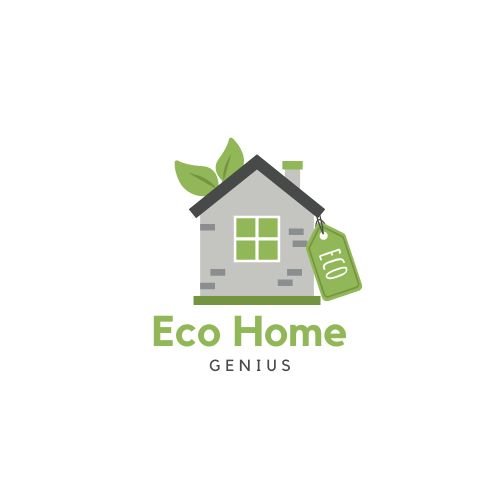
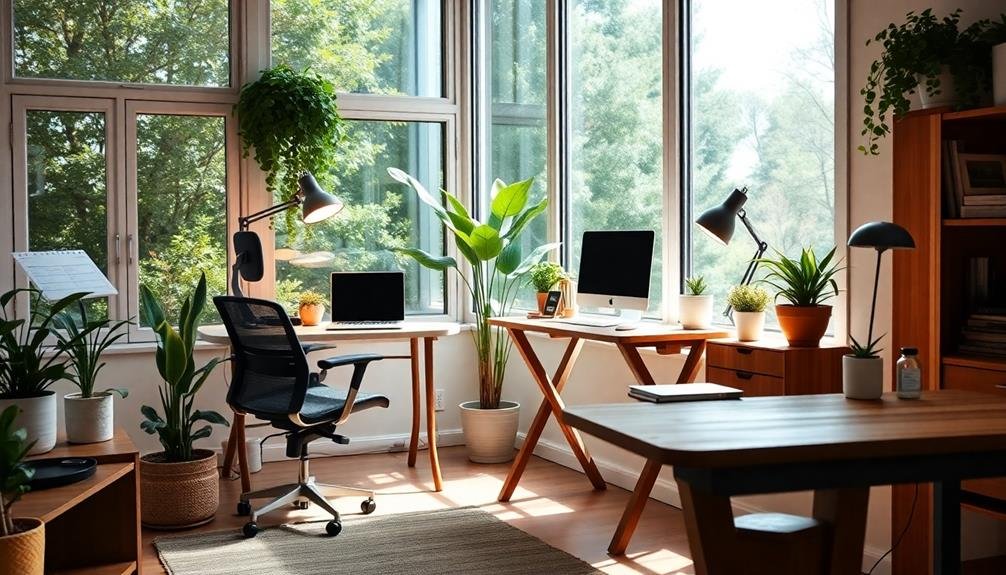
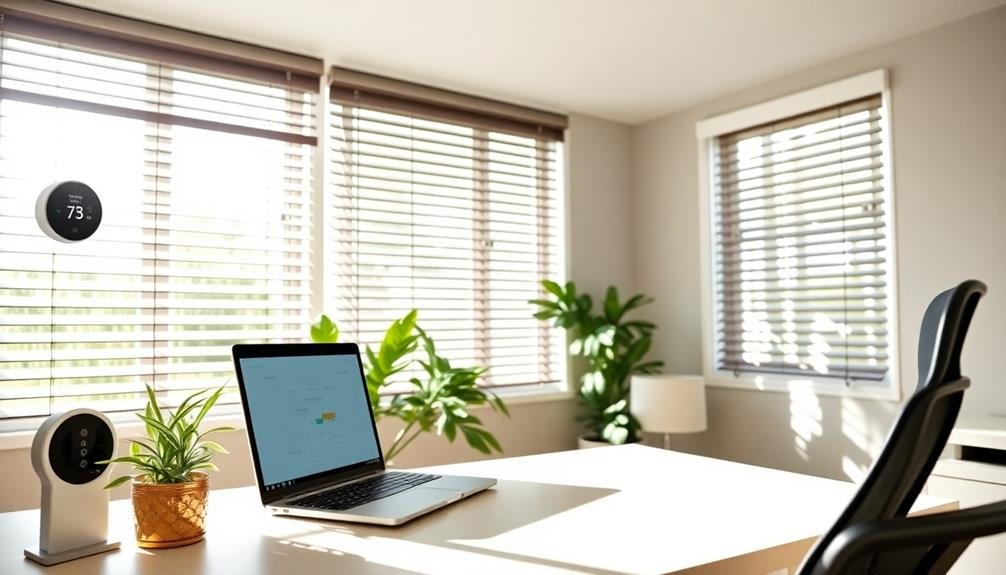
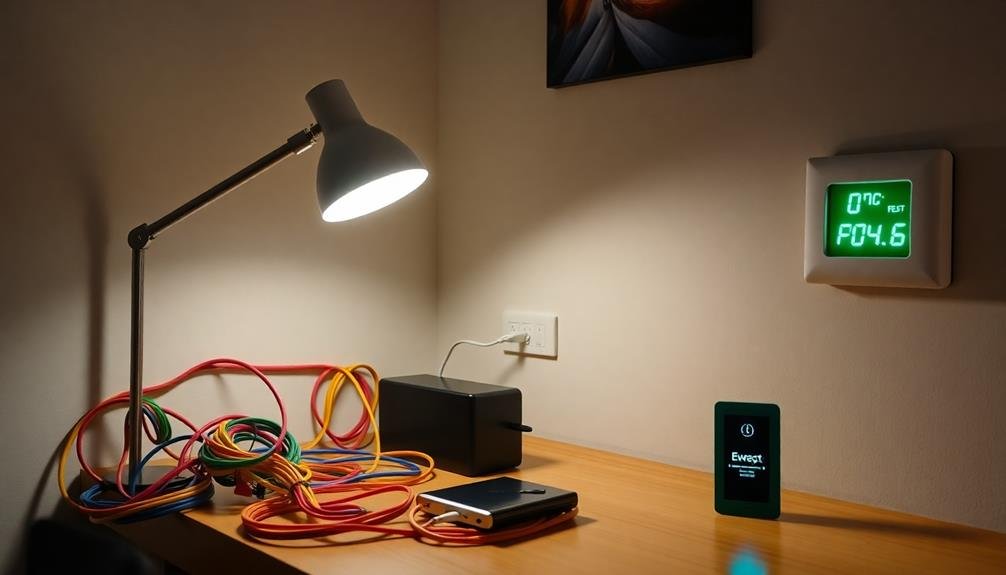
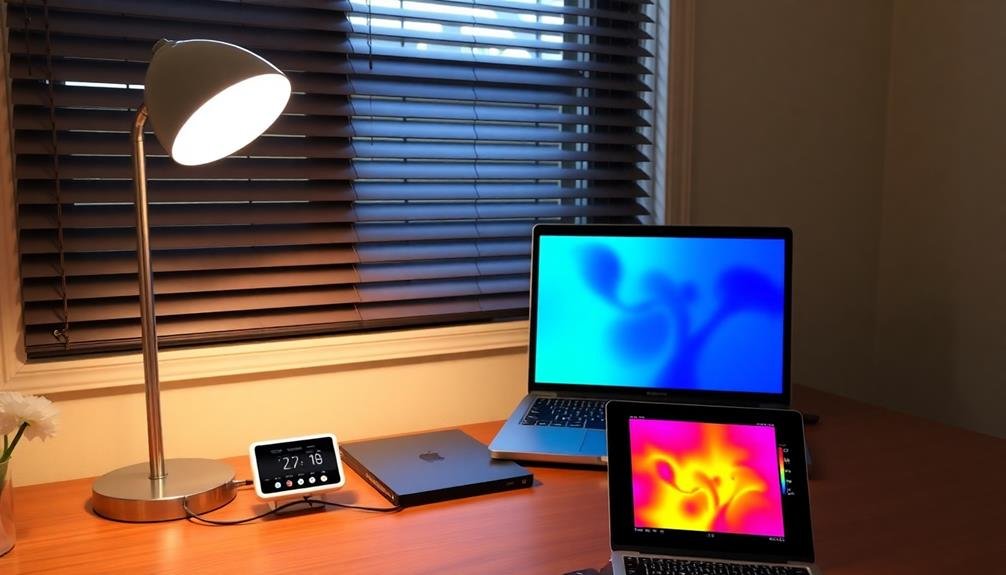
Leave a Reply